This is the third part of our series, “Agriculture’s sustainable future: Feeding more while using less.” The second article focused on the ongoing challenge of measuring the cost and benefits including the impact of farming practices that protect the environment.
Never mind that Trump-Pence sticker on the back of his Dodge Dakota pickup, Wes Kent and the way he manages his small, diversified farm in Virginia’s Shenandoah Valley figure big in Joe Biden’s vision for addressing climate change by paying farmers to reduce U.S. greenhouse gas emissions.
Biden’s plan to create a way for farmers to earn credits for climate-friendly practices is shared by multinational corporations that are eager to offset their emissions, leading farm groups that want to find new income streams for producers.
His plan, and the numerous private market programs that are springing up, face numerous questions: Can they pay enough to attract a critical mass of farmers? Will some farmers benefit more than others, based on where they farm or whether they can afford to adopt new practices and technology? And will farmers get paid somehow for steps they’ve already taken to slash greenhouse gas emissions?
Count Kent as interested in the idea of carbon payments. “Anytime there's a financial incentive, it gets you even more interested in doing what you're doing,” he said.
Kent, who raises dairy and beef cattle, plus 100,000 turkeys, currently earns $17,000 a year in conservation program payments for a range of practices he’s adopted since buying what was a starter dairy farm 20 years ago. One of many early moves was hand-seeding fescue in what he had first found as a mud flat where lounging cows had denuded the farmstead’s river bank.
His current practices include manure treatments to limit emissions of methane, a greenhouse gas; conservation tillage methods that avoid turning over the soil and releasing carbon dioxide into the air; and planting cover crops to build carbon in the soil and prevent the runoff of nitrogen and phosphorus into the nearby Middle River, part of the Chesapeake Bay watershed.
His aggressive pursuit of conservation practices aligns well with what the National Sustainable Agriculture Coalition (NSAC), in a recent series of blogs, enumerated as the best climate-change-fighting practices for U.S. farmers.
For Kent, the government payments from the Conservation Stewardship Program have been critical to making his farm sustainable financially, and covering the cost of his conservation work, which not only reduces his carbon footprint but helps curb pollution that for decades contributed to the Chesapeake’s large oxygen-deprived dead zones.
Programs like CSP can’t guarantee farmers long-term income — funding for the program is capped by the farm bill and farmers like Kent have no assurance of getting their five-year contracts renewed. Kent says his conservation practices are crucial in his profitability and he won’t stop doing what he's doing. “We're going to continue those practices after CSP; that's not going to change ... I'm going to continue those practices for sure.”
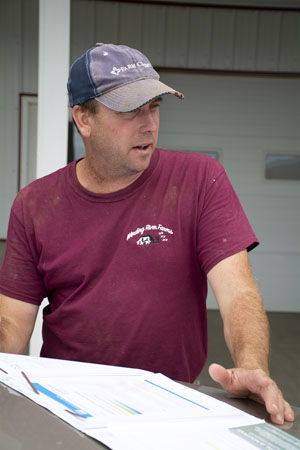
Wes Kent
But he’s not locked into these practices once his contract ends, and there is no guarantee that other farmers will continue the practices when their contracts expire, reversing some or all of the environmental gains.
Enter the idea of ag carbon markets.
A top adviser to Biden is proposing to create a carbon bank at USDA that would buy and sell carbon credits from farmers using a reverse action technique in which farmers bid the prices they want to be paid. The credits would then be sold to corporations such as energy companies that need to offset their greenhouse gas emissions.
The concept has won the endorsement of a new coalition of farm, food, forestry and environmental groups, called the Food and Agriculture Climate Alliance. The coalition includes the American Farm Bureau Federation, National Farmers Union, the National Council of Farmer Cooperatives as well as two major environmental groups, the Environmental Defense Fund and The Nature Conservancy. Other alliance partners include: FMI — The Food Industry Association, National Alliance of Forest Owners, and the National Association of State Departments of Agriculture.
The group calls for one-time government payments to “early adopters,” farmers that have already undertaken carbon-sequestration practices.
The group also endorsed making farmers eligible to earn transferable tax credits for emission reductions, but that would require congressional approval, and tax legislation could be especially difficult to move through a closely divided Congress over the next two years.
Several other private credit markets or carbon payment programs are already in the works or in operation. They include:
- The Ecosystem Services Market Consortium, whose founders include food and agribusiness companies such as General Mills, McDonald’s and Cargill, is already paying a few farmers in preliminary transactions and intends to open a broad-based private carbon market in 2022, paying farmers for a full menu of emission reducing practices.
- Indigo Ag, a high-tech farmer services firm, invited growers in mid-2019 to make 10-year commitments to sequester soil carbon at $15 per verified ton. American farmers have contracted 7.5 million cropland acres to apply climate-saving practices for 10 years and have already implemented practice changes on over 1 million acres.
- A year ago, the Seattle-based Nori Carbon Removal Marketplace appeared, offering individuals and businesses the choice to go online and use their credit cards to pay farmers for storing soil carbon. On the farmers’ side of the bargain, Nori invites farmers to use a computer app, COMET-Planner, to estimate of how much soil carbon they can sequester, pay an expert to verify, and then sell it via Nori.
- Germany-based Bayer is getting in on the act with a new Carbon Initiative that aimed to enroll 1,200 farmers in the United States and Brazil during the current marketing year. Bayer will pay farmers for the value of “carbon removal” practices. In Brazil, a government-run agricultural research agency will be enlisted to develop sampling tools to measure the practices’ impact. Bayer thinks the program may help meet the goals of the European Green Deal, the European Union’s plan to cut Europe’s greenhouse gas emissions and address other environmental challenges. By the end of the enrollment period in October, farmers had enrolled over 200,000 corn and soybean acres.
- There are regional efforts, too. The Florida Climate Smart Agriculture group is partnering with the University of Florida Institute of Food and Agricultural Sciences to develop the framework of payments for ecosystem services along with a tool to measure the services provided.
- California, which is the nation’s pioneer in using carbon markets to try to reduce emissions, created a cap and trade system that requires power plants, refiners, manufacturers and other polluters to reduce their carbon emissions or buy permits. Revenue from the permits has helped fund the widespread installation of dairy digesters, equipment on dairy farms that captures the methane gas emitted by manure to generate power.
A nationwide cap and trade program hasn’t been on the legislative horizon since the idea died in Congress in 2010, but Biden and private market developers are counting on there being a robust demand for carbon offsets from a host of corporations, including energy companies, airlines and even major food companies, that need to offset their emissions. Many have set emission targets to meet or exceed the Paris climate agreement’s goals for limiting global warming.
Biden urged to move quickly on carbon bank
A group of former Obama administration officials that have recommended a series of ways for the new Biden administration to immediately act on climate change argue that the carbon bank could be operated using the USDA’s Commodity Credit Corp. That’s the $30 billion revolving fund that President Donald Trump used to make trade assistance payments to farmers to offset the impact of his tariff war with China. The CCC is primarily used to make commodity program payments to farmers and to fund marketing loans for producers’ crops.
The carbon bank concept is the brainchild of Robert Bonnie, a former USDA undersecretary for natural resources who co-authored the “Climate21” recommendations and is now the leader of Biden’s USDA transition team. The Climate 21 report says Biden should consider announcing immediately that he intends to set up the carbon bank, possibly starting as a pilot project.
“A USDA carbon bank would provide a guaranteed price for producers while guaranteeing the environmental integrity of carbon conservation practices,” according to the “Climate 21” report outlining the recommendations to Biden.
“The CCC has up to $30 billion in borrowing capacity, about 60% of which is used annually for ongoing activities. If the CCC allocated even $1 billion annually towards purchasing carbon credits, at $20/ton, this could produce 50 megatons (50 million tons) in GHG reductions annually.”
By comparison, Walmart has pledged to reduce its supply chain emissions by a billion tons (the equivalent of taking more than 200 million cars off the road), with 200 million to 300 million tons of that coming from agriculture. Walmart is the world’s largest grocer.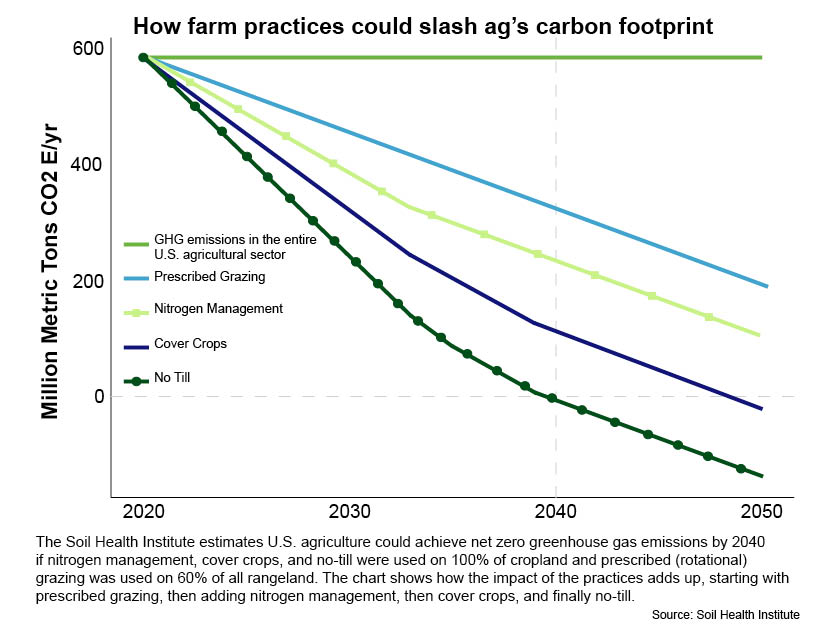
Ferd Hoefner, strategic policy adviser to the National Sustainable Agriculture Coalition, says a USDA carbon bank "would effectively be setting the price for carbon sequestration (or GHG emissions reduction) in the same way that the CCC once upon a time, long ago effectively set the base price for corn."
Debbie Reed, the executive director of the Ecosystem Market Services Consortium, says a USDA carbon bank has the potential of crowding out private carbon markets, depending on how expansive the government program is. Some critics of private markets think USDA would do a better job of policing credit trading.
But Reed doesn’t believe the Biden advisers intend to shut out private markets. To avoid disrupting private markets the government’s goal should be to “engage producers in USDA conservation programs that get them on the path of climate smart or ecologically beneficial practices, and that perhaps provides them a modest financial signal,” Reed said.
“The thing we are all struggling with is the public role,” Reed says, “and what USDA does to support these markets. We need a lot more technical assistance on the ground…that can help farmers and ranchers” to assess their potential to measure their stored carbon or other GHG fighting action, she says.
Once farmers “see the benefits of changing systems-based approaches in a manner that makes them more ecologically and economically resilient, they have a better understanding of how they might participate in a free-market approach such as ESMC’s,” she says.
Officials with Indigo Ag see the USDA carbon bank as another potential buyer of credits. Indigo could serve as an aggregator, buying credits from farmers and selling them to USDA.
“The CCC taking on this role would send a strong price signal to the private offset market overall and provide stable demand to the supply-side, encouraging both farmers and project developers to invest in project implementation,” said Laura Wood Peterson, senior director of government affairs for Indigo. “This allows USDA to reduce uncertainty for farmers and spur innovation from the private sector, as an engine of economic growth.”
$15 startup carbon market arising
The question most farmers want an answer to immediately is how much they could get paid. So far, the answer is about $15 per ton.
For perspective, a farmer in the Midwest could realistically sequester half a ton to a ton of carbon per acre using such practices as conservation tillage and cover crops, according to Jerry Hatfield, a retired USDA soil scientist who has served on a special study committee for the UN's Intergovernmental Panel on Climate Change.
Indigo Ag has a range of companies wanting to buy carbon offsets, such as Boston Consulting Group, Dogfish Head Craft Brewery Inc., and Shopify Inc., says Kari Hernandez, Indigo's director of carbon operations. Those firms "want to mitigate their own emissions at the same time they’re investing in farmers” to help them succeed, she said.
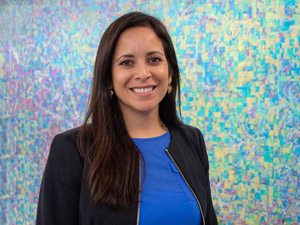
Kari Hernandez, Indigo
Its acreage contracted so far is across 21 states, mostly in the Midwest and Central Plains. The contracts are largely corn and beans areas but includes a lot of crops in other rotations.
Indigo is signing contracts at $20 a ton, $15 of which would go to farmers. So contracts provide a farmer with up to $45 per acre if three tons per acre of new carbon storage can be verified during the 10 year period.
The $5 a ton that goes to Indigo Ag provides the company’s margin and covers costs of carbon verification by a second company, Verra Verified Carbon Standard.
Nori’s pricing is similar. Still in its pilot stage, the project keeps a transaction fee of 10% to 15% and gives the farmer the rest, which is $15 a ton, from which the farmer pays a verification fee, says Aldyen Donnelly, Nori carbon economics director.
Donnelly says Nori had just two landowners as carbon credit sellers by October 2019, selling to about 760 buyers. But the firm has been determined to first set up a true retail system allowing any consumer with a valid credit card to buy GHG offsets. That done, she says, the firm now has “a greater focus on aggregating supply for and securing large corporate buyer demand.”
Meanwhile, ESMC’s trial prices for all types of emission mitigation are based on market analysis, says Executive Director Debbie Reed. She says its soil carbon prices have topped out at about $20 a ton and are "trending towards $15/ton" but range widely.
ESMC, supported so far with over $23 million from corporate members and USDA’s Foundation for Food and Agricultural Research, has research proceeding at several sites in the Southern Plains and Corn Belt, with much of the research headed by the Oklahoma-based Noble Research Institute.
Reed says ESMC’s lineup of eager corporate customers has “grown tremendously even from a year ago. General Mills is a perfect example. Their food sales have gone up so much during COVID that they had to … do more because they have a larger footprint coming from agriculture.”
Significantly helping new players in a carbon market is the arrival of faster, cheaper, more precise technology for measuring soil carbon, monitoring emissions, and otherwise helping make a complex market manageable.
ESMC invested in a phone app that can show a grower where on-farm soil samples are needed. Without the app, a farmer has to pay $2,000 or more for an expert to complete such a soil sampling plan, she said.
The actual carbon price that a farmer gets will align with actual amounts of soil carbon and emissions reductions farmers and ranchers can verify and offer, but that can’t happen until the private markets include open price discovery and transparency, which she says are lacking now.
Indigo’s Hernandez said payments for soil carbon have been more typically about $3 a ton, so the $20 in Indigo Ag contracts “is a big change,” and is intended to make contracts “worth it for farmers”
She said the soil carbon price “will change over time” as does any product as its market develops.
Carbon prices need to increase a lot, according to Rattan Lal, an Ohio State University soil scientist who was awarded the 2020 World Food Prize for his work in promoting carbon sequestration to address global environmental challenges, including climate change. He believes the price of carbon has to be closer to $40 a ton to truly make an impact on greenhouse gas emissions.
“I’ve talked to some (farmers) who were offered $10 a ton, and that is 25% less than seed for a cover crop, or even less. If you want to grow Daikon radishes as a cover crop, the price of seed is very high,” he said.
The Soil Health Institute estimates that farmers are only using cover crops on 4% of U.S. cropland, and the practice won’t grow until there are better incentives, Lal said.
Credible benefits for storing carbon are needed even more worldwide, Lal said, especially with small-stakeholder farmers in America and “in Mexico, Honduras (central America and Caribbean) … where they have nothing. Paying them a few pennies (for carbon) is not enough” he says.
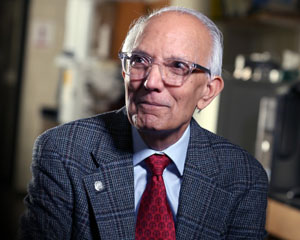
Rattan Lal, Ohio State
“Certainly a $40 price will be more attractive than $15,” says Hernandez. But the $15 for farmers, meanwhile, “changes the way they farm, such that it also reduces their costs and increases their revenue…making the farmland more resilient, holding water. The profitability equation is changing.”
Planting cover crops can cost a farmer up to $50 an acre, depending on the type of seed that’s used and other factors, but growers can also save on fertilizer, weed control and erosion control costs, according to experts. A study by the Sustainable Agriculture Research and Education, a federally funded program, estimated that cover crops would yield a net return to corn growers of $17.90 after five years.
In California, 'inconsistent' funding and few ag offsets
California’s pioneering effort to reduce its greenhouse gas emissions has fueled the building of methane digesters across the state’s huge dairy industry, and the cap-and-trade program also has provided some financial assistance for installing new farming practices. A limited number of farms also can earn offsets that they can sell to companies that need to offset their emissions, which is the goal of ag carbon markets.
The California program works by imposing limits on refiners, power plants and other emitters, requiring them to buy allowances for their emissions. The sale of those allowances in turn has helped provide cost-share assistance to dairy farms to install digesters, which capture the methane gas from manure and use it to generate electricity. Polluters can also purchase a limited amount of offset credits, mostly generated by forestry projects but a few by dairy producers' systems for capturing methane.
Revenue from the allowance sales has fallen sharply this year, because fewer polluters are buying them. Some 52.6 million were sold in August, down from 66.3 million the year earlier, and only 21.2 million were sold in May, down from 66.3 million in May 2019. The average price of the allowances this year is under $17 a ton.
As of the 2019-2020 budget year, $294 million in allowance revenue had been allocated to the dairy methane program. Projects being implemented by California dairy farms are expected to reduce their methane emissions by 25% compared to what they were in 2013, according to the California Department of Food and Agriculture. However, some farms have had challenges selling the power into the grid, while others are using the energy for milking parlors or to power vehicles, said Taylor Roschen of the California Farm Bureau Federation.
She said some funds from the program also have been used in ways similar to USDA’s Environmental Quality Incentives Program to help farmers pay for improvements to soil management practices, irrigations systems, and manure management systems. Still, “funding has been inconsistent and it’s been a fight every year to ensure funds are dedicated to ag work and that programs aren’t narrowed to be accessible to only the few,” she said.
There is currently some discussion about making it possible farmers to earn offsets for carbon sequestration practices.
Methane capture projects on dairy and swine farms can currently qualify for offsets, and rice farms can earn credits for practices that make documented reductions in methane emissions from their fields. As of September, the California Air Resources Board had issued over 200 million offset credits; only 3% originated with livestock farms and none of the offsets came from rice projects. Most offsets have come from forest projects.
No agricultural carbon sequestration projects have been made eligible to earn credits in part because of a requirement that the carbon remain in the ground for 100 years, an impossible standard for agriculture to meet, said Gabriele Ludwig, director of sustainability and environmental affairs for the Almond Board of California. Almond growers had hoped to get offset credits for whole orchard recycling, which involves grinding trees into chips and discing them into the soil. The practice not only sequesters carbon but also has been shown to increase yields in the new orchards after several years.
Soil carbon markets face practical hurdles, critics
Nationwide, even a startup $15-a-ton carbon market faces technical and regulatory barriers, and there are critics, including many environmental groups, that don’t believe the reduction greenhouse gas emissions will be meaningful or lasting.
Other critics fear that the markets will primarily benefit certain regions, the Midwest in particular, and large-scale growers and livestock producers who can afford the costs of cover crops, methane disasters and other improvements.
Many environmentalists aren't convinced that agriculture can be used effectively to offset greenhouse gas emissions.
Craig Cox, senior vice president of agriculture and natural resources for the Environmental Working Group, says there are continuing concerns that agricultural carbon sequestration won’t be permanent, which is the reason for California's tough rules on offset credits. “The carbon that’s sequestered is pretty vulnerable to being rereleased to the atmosphere” when farmers change practices or break up land, he said.
Scientists with the World Resources Institute argue that many regenerative agriculture practices can in fact improve soil health “and yield some valuable environmental benefits, but are unlikely to achieve large-scale emissions reductions.”
They don’t think storing carbon in the soil is yet proven to be an effective way to fight climate change overall, and they worry converting cropland to pasture would only result in converting other lands to crop production in order to maintain food supplies.
“Given the projected global need for at least 50% more crops per year by 2050 relative to 2010, removing cropland from production in one field without additional efforts to make up the food deficit requires plowing up land elsewhere to replace the food production. That releases carbon stored in both soils and plants,” offsetting the original carbon reduction, WRI researchers say.
Some policymakers have suggested expanding USDA’s land-idling Conservation Reserve Program as a way to sequester carbon and increase commodity prices, but the idea so far appears to have little congressional support. Economists warn overseas competitors would likely expand production to make up for a cut in U.S. crop acreage.
WRI also argues that adding manure to fields can increase soil carbon, but “the feasibility of scaling such practices over large areas to substantially increase soil carbon and mitigate climate change is much less clear.”
Meanwhile, the potential regional disparities could create political challenges for policymakers if the government is involved in carbon markets.
Hatfield, the soil scientist, says that farmers in the Corn Belt has the best chance to benefit from selling carbon offsets because the region's soil and climate, including reliable precipitation, make it ideal for producing vegetation and deep roots. "That's not to say that we won't, we can't, do it in any other parts, it's just not going to be at the same degree," he said.
Areas of the South, including Alabama and Georgia, with a long growing season as well as ample rainfall also have a lot of potential, as well as irrigated regions. Building soil carbon will be harder for farmers in hot, dry areas such as the southern and western Plains, he said.
Asked about the potential regional disparities in carbon payments, American Farm Bureau Federation spokeswoman Terri Moore said, "Regional variances and diversity are important to recognize. That’s why we support a voluntary system that includes climate hubs and a wide range of options so farmers and ranchers can find the best program for their land."
Suspicion about a private market
One immediate problem the private markets face is a shortage of technical assistance for farmers who want to assess their potential to participate, said Reed of the ESMC.
A bipartisan bill introduced in the House and Senate this year, the Growing Climate Solutions Act, is intended help address that shortage by authorizing USDA to certify private entities to advise farmers and verify the validity of carbon offsets.
But a key Senate Republican, Sen. John Boozman, R-Ark., who will be the chairman of ranking member of the Senate Agriculture Committee in the next Congress, isn't sold yet on private carbon markets. He said he's concerned that most of the economic benefits will go to the companies that trade in the credits, not the farmers that generate the offsets.
Reflecting suspicions among some farmers, the National Sustainable Agriculture Coalition prefers to see the federal government focus first on expanding conservation assistance through the Conservation Stewardship Program to promote climate-friendly practices. Before a private carbon market emerges, it’s crucial “to have the incentives in place so we’re not incentivizing production in lands that should not have crops," said Cristel Zoebisch, NSAC's climate policy specialist.
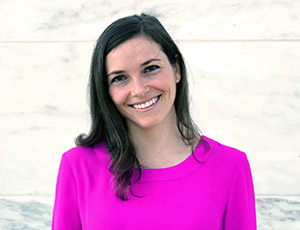
Cristel Zoebisch, NSAC
Also, scale is important, Zoebisch says, and “what we’ve seen is that carbon markets tend to work for larger scale operations.” Big corporations ready to pay farmers to store carbon “might not be interested in reaching out to small-scale farmers,” she said.
NSAC and the Environmental Working Group would like to put more money into farm bill conservation programs with a focus on promoting regenerative agriculture practices. "I’m a huge, huge fan of soil health and regenerative agricultural praise and agroecological practices," said EWG's Cox. "I would love to see CSP really, really focus on getting those practices out on the landscape," he said.
But Congress is not scheduled to pass a new farm bill until 2023, and the incoming Biden administration appears moving more quickly than that. Also, CSP funding is dropping significantly under the 2018 farm bill, so lawmakers would have to find more funding just to keep its funding level with that it has been getting.
ESMC’s Reed insists smaller scale farmers will benefit from generating carbon offsets because farmers and ranchers can earn credits from many climate-smart crop, pasture and livestock practices.
Further, she says, to ensure longevity to the climate-friendly practices, ESMC participants will have to make 10-year commitments to maintain them. “We are tracking every single year for 10 years … (and) every year is a new year, and you get paid for everything you do that year,” she says.
Livestock operators can claim a big slice of agriculture’s GHG reductions, cutting methane and nitrous oxide (from ammonia) emissions with biodigesters and other climate-smart waste management practices. The Intergovernmental Panel on Climate Change says those two gases, respectively, contribute 58 and 206 times more per pound to atmospheric global warming than the carbon dioxide that comes from tailpipes.
So, when Wes Kent’s Winding River farms puts the nutrients from manure, turkey litter, and cow bedding back into the soil, keeping it away from streams and the air, it’s a punch against climate change. “Animal agriculture is not the problem people say it is; it’s a solution” to climate change,” he said
Meanwhile, some alternative paths may emerge to bring farmers value for soil carbon. A better deal on a farm loan, for example, or a discount on crop insurance rates.
Interested in more coverage and insights? Receive a free month of Agri-Pulse.
The Biden advisers’ Climate21 report and the new Food and Agriculture Climate Alliance both want the incoming administration to consider how to use the crop insurance program to incentivize climate-friendly practices. The Climate21 report said that adjusting crop insurance rates and policies would have “the potential to influence management practices across tens of millions of acres, if not more.”
A California-based group, Land Core, is completing “an actuarially sound model of the risk-mitigating benefits of soil health practices” to be available as a tool for lenders and insurers to plug into farm loans and insurance of farm assets.

Aria McLauchlan, Land Core
Land Core Executive Director Aria McLauchlan said that “if a bank gives a farmer a 10-year loan, and the farmer has a management plan that includes good soil health practices…the farmer should be rewarded for that because risk is reduced…because as you increase the quality of the soil you also increase the water holding capacity, resilience to flood and drought.”
“Carbon sequestration may take some years to start measuring,” she says, “but a better loan rate or loan terms based on confirmed soil health practices is something that can be offered to a farmer in the first couple of years.”
Another option: Save the farm
Kent, the Virginia farmer, said he would be interested in a USDA-run carbon program “as long as there weren’t too many hurdles to jump over. I'm sure it would be more of a burden on the agency guys than it would be on me,” referring to the department’s likely need to verify what he was doing.
For now, his annual CSP payments "more than cover the expenses for things we’re doing. I’m getting paid for my time,” which includes taking nitrate tests, monitoring progress of his CSP plan with NRCS specialists, etc.
His adoption of soil health, pasture improvements, clean water, nutrient management and the like also have improved the farm’s productivity. He estimates his yield on corn silage has jumped at least three to four tons an acre over time and averages 18 tons to 19 tons in recent years, more in river-bottom land, he said.
But Kent believes perhaps the best thing he’s done for the natural environment has been building a resilient farm that can be profitable for the next generation of farmers. That is, instead of selling the land for other uses.
“One of our biggest problems here is there’ll be a 200-acre farm sold and split up into 20 housing lots. So, you have a really nice house built on 10 acres, and then all the people there do is mow it. It’s gone then. None of us — real farmers — want to fool with a little piece like that. It’s unhandy even to go in and make hay off of.”
Many farm advocates agree.
About 2,000 acres of U.S. agricultural land per day are converted to other uses, says Mitch Hunter, research director for American Farmland Trust.
In its update this year on the shrinking U.S. farmland, AFT reported 11 million acres of the nation’s agricultural land was converted to other uses from 2001 to 2016, and Hunter says 6.6 million acres of forestland was lost in the same period. The total, 17.6 million, by comparison, exceeds the area of West Virginia and Delaware combined.
Further, such conversions aren’t one-for-one trades. A University of California, Davis study found, for example, that greenhouse gas emissions per acre for urban areas in Yolo County were 70 times greater than for irrigated cropland.
Next: What advancements in biologics and other forms of agricultural technology could be vital to combating climate change and addressing other environmental challenges.
For more news, go to Agri-Pulse.com.



